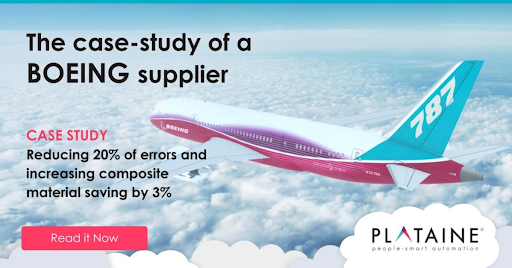While the market for aerospace composites is growing — with carbon fiber reinforced polymers (CFRPs), ceramic-matrix composites (CMCs) and honeycomb materials methods for tackling associated production challenges have stagnated in many factories. For example, based on hundreds of conversations we have had with manufacturers, at many aerospace manufacturing sites, up to 12% of work orders are regularly late and there is no comprehensive system for tracking information on bottlenecks at stations, availability of tools, material shelf-life or the stations and machines condition.
The number of elements on a factory floor that might cause a particular efficiency or quality problem make it nearly impossible to pick out a single tool, process or condition as the culprit.
Due to supply chain disruptions (post-Covid), factories experience material shortage while logistics and procurement managers testify that material orders that used to be fulfilled in weeks now take months.
Many manufacturers are turning to Industry 4.0 software with AI-based algorithms, that’s tailor-made for aerospace composites, in order to deal with specific challenges including:
Lack of material and asset tracking capabilities leading to:
- Waste of costly, time sensitive material
- Inefficiencies in monitoring material shelf-life
- Poorly planned schedule and synchronization between freezers and autoclaves
- Failure to process material based on expiration date (with expiring materials used first);
- Failure to leverage efficient and dynamic cutting plans that account for upcoming demand and maximize utilization of material with multiple work orders per unit
- Tool misplacement in large factories causing delays in production
- Quality issues leading to rework — costs aerospace composites manufacturers can’t afford due to the expensive material waste and generally thin margin for error
What makes Industry 4.0 software for aerospace composites the answer? It boils down to the combination of AI and IIoT technologies to user-friendly Digital Assistants. For example:
- Material and asset tracking leverages IIoT sensor technology to automatically collect data on every unit of material in the factory from the minute it arrives to deliver intelligent real-time recommendations to eliminate error and waste. The same process is done with equipment and operations. The result is 100% traceability and therefore control.
- Shelf-life management of time and temperature sensitive materials, such as pre-pregs and resins, to ensure quality and prevent rework and waste. Time sensitive material manager tells the factory managers which materials they should use first, what’s the status of the material that’s defrosted, which rolls must be sent to the lab before being expired and so forth.
- The tool manager keeps track of tools in real-time, learns the regular patterns, and alerts when there’s a deviation (misplacement for instance) so production will never be halted or delayed because of a lost tool.
- The production scheduler’s AI algorithms use data on variable demand, resources, materials and tools to automatically generate plans to maximize factory resources and ensure on-time delivery. It creates plans from the freezers, to the cutting, to the autoclaves or other workstations, based on the dynamic demand – it also adapts to changes rapidly, knowing how to change the plans in real time (when, for instance, a workstation is not active, a machine goes into maintenance, or that another unexpected event occurs)
- The Cut and Kit optimization (FabricOptimizer) balances material utilization and kitting operations to automatically create optimally efficient and dynamic cut plans. Instead of cutting parts in silos, it considers the demand, selects a sheet that fits (while trying first to use the short ones and not open new ones) and cuts materials for several work orders in parallel, in a way that minimizes the waste.
Successfully reaching the Factory of the Future level with Industry 4.0 technologies, requires software to solve specific challenges that are part of the day to day work life in the Aerospace composites industry.
Here are the 6 key questions aerospace composites manufacturers should ask when selecting the optimal solution.
1. How does the software manage composite material and prevent errors?
Manual tracking of remaining time sensitive material shelf life could produce miscalculations and errors resulting in scrap and rework. When working on composites, the costs are particularly high.
The higher the level of automation around such materials a solution supports, the less chance there is for human error and the less manual efforts and resources are required. For instance, automated data flow from the material receiving area, through freezer storage, defrost, production and curing prevents potential errors. Plus, extreme automation frees the workforce to focus on their manufacturing value-added tasks.
These are the features of a dedicated AI-based solution designed for the aerospace composites industry that combines data from the factory floor and machine learning capabilities.
2. Does the software offer just tracking and optimization, or also a layer of insights and recommendations (proactive intelligence)?
Tracking and optimization — especially of time sensitive materials, cut plans, etc., in the case of aerospace composites — are important. Automated data tracking is great.
However, to reach the highest level of productivity, efficiency and cost savings, you need a solution with predictive power on top of its automated tracking capabilities.
You may hear a lot of buzzwords like “digitization”, “digital transformation” and “data analytics.” These don’t equate to features that will predict production delays, inventory issues or the need for maintenance; suggest the right rolls to maximize material utilization, reduce waste and save costs, or interpret context and past patterns to suggest optimal factory work plans.
Ask this: in addition to data collection, does the solution proactively generate relevant insights in real-time? For example, does it automatically assign the relevant pre-preg material (based on expiration and shelf-life parameters) for the upcoming work orders? What about accurate management of defrosting time for production-readiness, new inventory procurements (based on upcoming production plans) etc.?
Make sure your software solution is A. Tailored to the Aerospace composites industry and B. Proactive and features AI algorithms that don’t just render colorful charts and graphs, but actually recommend actions in real-time that positively impact production.
3. How does the software integrate with your existing systems?
Manufacturers typically have existing systems, such as ERP and MES running in their environment. It’s important that these systems all can communicate with the new Industry 4.0 AI and automation layer to avoid problems such as broken information flow, different data formats, having to re-enter data, migration challenges and data loss. It’s also important to ensure that the integration is smooth and easy – plug and play style.
Make sure the solution you choose supports communication protocols common across your existing and legacy systems. This is crucial to avoid information gaps and enable AI-based predictions that depend on data collection from multiple sources.
4. Will the software result in attractive ROI and if so, how long will it take?
This is so obvious, one might think it does not need mentioning. However, not all software implementations can demonstrate a clear ROI, so it’s important to ask how exactly that’s achieved.
Look for a solution with proven metrics around factors that translate to real cost savings and productivity improvements. For example, at Plataine, we have seen ROI in as little as four to six months from improvements in these key areas:
- Product cost reduction: 5% – 15%
- Inventory reduction: 10% – 15%
- Labor savings: 5% – 20%
- Rework reduction: 10% – 40%
- Faster time to market: 10% – 25%
- Factory throughput increase: 5% – 10%
- Reduction in quality risks: 10% – 20%
5. Are the solution’s main use cases and value proposition specific to aerospace composite manufacturers’ needs, or are they more general?
If a solution doesn’t understand time sensitive material management, freezer-to-autoclave scheduling and cutting-pattern optimization out of the box, will you be able to invest in expensive and risky customization and development? A solution designed specifically for the aerospace composites manufacturing vertical will get you out of the gate running (towards ROI) faster and with less work than more general IIoT software.
Look for a solution with aerospace composites manufacturing use cases and ready-made tools built in, like:
- TIme sensitive Material Manager
- Material & Asset Tracker
- Cutting & Kitting Optimizer
- Production Scheduler
6. What key added parameters are essential to your manufacturing business?
No two aerospace composites manufacturers are totally alike. Make sure the solution you’re considering has the additional features that serve your unique needs. Some common desired features include:
- Cloud-based solution that require no installation
- Quick and easy implementation that could be done on-site or remotely
- Zero downtime during implementation
- Ease of use that will allow your staff to operate the system in no time
- Data security that complies with your IT and operations requirements (ISO, ITAR, Gov Cloud and alike)
Summary
In aerospace composites manufacturing, the margin for error leaves practically no space for mistakes, however minor. Many factory tasks require a degree of precision that can be nearly impossible for the workforce to deliver reliably. Since Industry 4.0 technologies are being implemented by the industry, the standards are only getting higher, as well as the competitive edge that manufacturers that leverage innovation have. Picking the optimal Industry 4.0 solution for manufacturing optimization is a crucial step towards overcoming critical challenges to reducing costs, improving quality and boosting productivity.
Post Covid has brought new challenges related to the supply chain, the time of new inventory arrival and the cost of composite material. Therefore, smart time sensitive material management is even more important these days. Just think about improving your material utilization by 10%.








